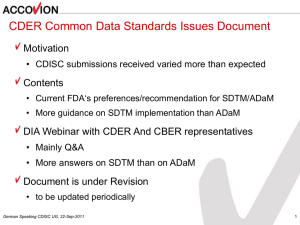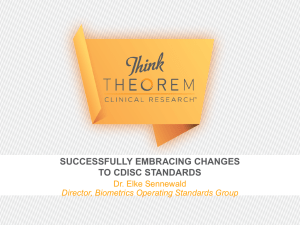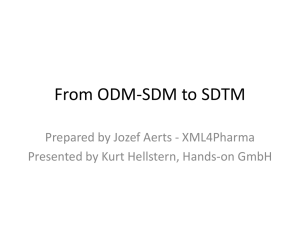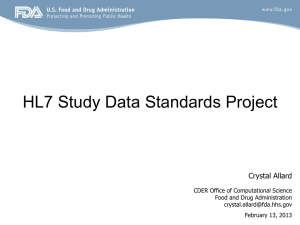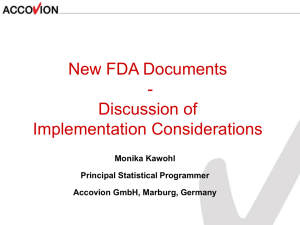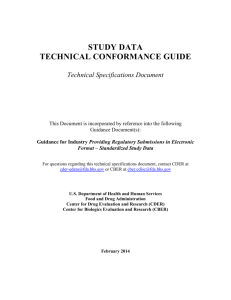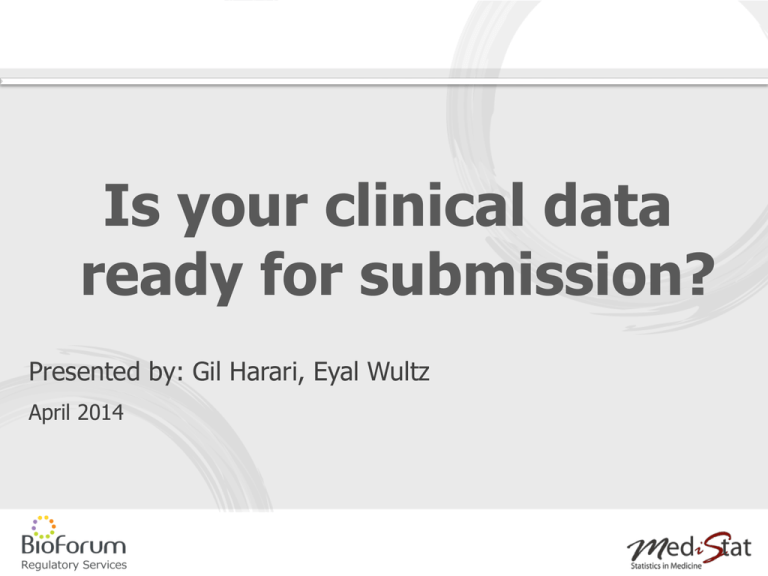
Is your clinical data
ready for submission?
Presented by: Gil Harari, Eyal Wultz
April 2014
IATI ROUNDTABLE - AGENDA
Strategy and statistical considerations in clinical trials
planning (Gil Harari, MediStat)
Clinical data submission – which way to go? (Eyal Wultz,
Bioforum)
Q&A
CLINICAL DATA SUBMISSION
Bioforum Regulatory Services
Clinical Data Standardization – importance and priority
Legacy-based submission
CDISC-based submission
Which way to go?
BIOFORUM SERVICES
BIOFORUM REGULATORY SERVICES
Bioforum
Regulatory Services
Clinical
Programming
Regulatory
Operations
Pharmacovigilence
Operations
• Clinical programming –
study support (tables,
listings, figures)
• Prepare data for
submissions
• Documents publishing
• eCTD compilation
• Lifecycle management
• Adverse events
processing and reporting
• CIOMS, MedWatch,…
• PSURs, DSURs,
Over 100 studies to date
Over 40 submissions to
the FDA, EMA, UK,
Germany, Spain
THE IMPORTANCE OF CLINICAL DATA STANDARDS
• There has been a sharp increase in Refuse-to-File (RTFs)
issued by the FDA from 2009 onwards1
• Main reasons include2 –
Clinical data deficiencies and ‘Data Presentation’
(~39%)
CMC issues (~28%)
eCTD issues (25%)
Other (8%)
1
June 2011 issue of Nature Reviews: Drug Discovery, Volume 10, page 403
2
Based on publically-available RFTs.
THE IMPORTANCE OF CLINICAL DATAS STANDARDS
Sanofi, Bayer’s Lemtrada receives FDA refuse-to-file letter in relapsing MS
By Lianne Dane , Created 08/27/2012 - 08:35
Sanofi’s Genzyme unit on Monday announced that it received a refuse-to-file letter from
the FDA regarding its application for the approval of Lemtrada (alemtuzumab) as a
treatment for relapsing multiple sclerosis. "We have had constructive dialogue with the
FDA, and we are very confident in our ability to address the agency’s request and
resubmit rapidly," remarked Genzyme CEO David Meeker.
Genzyme, which is developing the therapy with Bayer, said regulators requested that the
company "modify the presentation of the data sets to enable the agency to better
navigate the application." However, the agency did not request additional data or further
studies, the company noted.
The drugmaker indicated that a filing submitted to the European Medicines Agency was
accepted and the review process is underway. Last week, Sanofi announced that it was
withdrawing a stronger dose of the therapy, which is sold under the brand name
Campath, in the US and EU to prepare for the launch of Lemtrada.
PREPARING CLINICAL DATA FOR SUBMISSION
Legacy
Package
Conversion
CDISC
Conversion
Prepare
clinical
data for
Submission
Submission
Data
Package
LEGACY-BASED CONVERSION
Legacy Package
Conversion
CRT Changes
Case Report Tabulation
Change study data to comply with
FDA Study Data Specification
Guidance
Standardization
changes
Standardize common
datasets across all studies
CRT REQUIRED CHANGES
• Formats – remove variable formats. Split formatted variables into
two variables.
• Labels – add labels to datasets and to variables, confirm
uniqueness of variable names and labels
• Dates/time format – verify consistency throughout the studies
• Change variables order – according to FDA guidance
• Verify the key variables (subject ID, visit) in all datasets
• Split variables with value greater than 200 characters
• Split datasets greater than 1GB.
• Convert datasets to SAS Transport format.
STUDY STANDARDIZATION
• Standardize common datasets across all studies
Compare common domains (demographics, adverse
events, labs, physical exams etc.)
Create a standard domain structure specification given
the varies studies including
– Standard variable names, labels, types, value codes, order
– Approach for handling clinical significance and out of range
Standardize dataset names and labels
Change each study according to specification
ANALYSIS DATASETS CHANGES
• Analysis datasets are a must!
• Apply the same standardization and CRT changes to derived
variables
• Add core variables (as defined by the FDA) to all datasets
(study, center/site, country, treatment, sex, age, race, etc.)
• Revise the analysis programs according to the updated clinical
data.
• Verify existing outputs (tables, listings, figures) haven’t
changed
PREPARING CLINICAL DATA FOR SUBMISSION
Legacy
Package
Conversion
CDISC
Conversion
Prepare
clinical
data for
Submission
Submission
Data
Package
CDISC and its Standards
• CDISC – The Clinical Data Interchange Consortium, non-profitable
organization, that defines the world-wide standards for representing
clinical data, required by the regulatory authorities as part of
submissions
• SDTM – Study Data Tabulation Model, representing the collected
clinical data in standardized structure and controlled terminology.
• ADaM – Analysis Data Model, representing study analysis data in
defined datasets structure.
• CDASH - Clinical Data Acquisition Standards Harmonisation ,
describes the basic recommended data collection fields for 18 domains
• SEND - Standard for Exchange of Nonclinical Data, defining the
structure, and format of standard nonclinical tabulation datasets
FDA’S VIEWPOINT ON CDISC
• SDTM and ADaM are the only two standards supported at FDA for
submission of study data
“By supported, we mean that the listed FDA component has established
processes and technology infrastructure to support the receipt, processing,
review, and archive of study data using these standards. The submission of
standardized study data using any standard not listed… should be discussed
with the Agency in advance”
FDA Study Data Standard Catalog
• Submitting Non-standard legacy data
“The submission of non-standardized datasets is not recommended… There
are no further specifications for organizing legacy datasets”
FDA Study Data Specifications, 7/18/2012
FDA’S VIEWPOINT ON CDISC (cont.)
• The FDA has published several new guidances on standardized
study data for electronic submissions
• The FDA has listed the CDISC standards as the only acceptable
standards to be used for study data submission
• The FDA will still accept legacy-based clinical data for studies that
are starting within 24 months after the FDA register their new notice
(planned within the next 6 months)
• After that, only CDISC-based clinical data will be accepted
INDUSTRY PERSPECTIVE
More sponsors are now submitting CDISC-based clinical
data
However, not all CDISC-based submissions are equal…
From CDER1
• “CDER has received numerous “SDTM-like” applications over the
past several years in which sponsors have not followed the
SDTM Implementation Guide completely”
• “aspects of particular sponsor implementations have actually
resulted in increased review difficulty for CDER reviewers”
1CDER
Common Data Standards Issues Document, Dec 2011
SDTM CONVERSION – EXAMPLE
Subj. id
Date
Albumin
Alkaline
Phosphatase
Leukocytes
001
01/04/
12
30 g/L
398 IU/L
5.9 10^9/L
Lab - external
Subj. id
Site
Visit
Visit
date
Test
Category
Status
Comment
001
001
3
01/04/12
Chemistry
Done
Subject wasn’t in 8 hours
fast
001
001
3
01/04/12
Hematology
Done
Two samples were taken
USUBJID
VISIT
NUM
LBDTC
001-001
3
2012-04-01
001-001
3
001-001
3
LBTESTCD
Lab - CRF
LBSTRES
C
LBSTRESU
LBORNRLO
LBORNRHI
Comment
ALB
3.0
g/dL
3.4
5.4
2012-04-01
ALP
398
IU/L
44
147
2012-04-01
WBC
5.9
10^3/uL
4.0
11.0
Subject wasn’t in
8 hours fast
Subject wasn’t in
8 hours fast
Two samples
were taken
LB SDTM
DATA VALIDATION WITH CDISC
• Conversion with CDISC is ‘invasive’ -> validation is rigorous
• For SDTM
‘Mirror’ programming
OpenCDISC®
Manual verification
• For ADaM
ADaM-SDTM comparison
Double programming for imputed variables
Compare to CTR (if applicable)
STUDY DATA SUBMISSION PACKAGE
• Standardized clinical Data
• Standardized analysis data
• Analysis Programs
• Define.pdf/xml for clinical and analysis data
• Annotated CRF
• Reviewers guide
• Programs Guide
CDISC VS. LEGACY – SUMMARY
• Legacy
Pros
–
Less invasive -> less effort in conversion and verification
Cons
–
Not recommended by FDA (but acceptable in the short term in certain cases)
• CDISC
Pros
–
FDA’s favorite
Cons
–
Usually more invasive
»
More effort performing conversion
»
More validation required
TIMES ESTIMATES
CDISC – ~3-5 months
1.5-2.5 months
ADaM creation and verification
1.5-2.5 months
SDTM conversion and verification
2 weeks
3 weeks
1 week
Define xml
Define xml
PKG
2-3 weeks
Analysis data
conversion &
verification
2-3 weeks
1 week
Clinical data
preparation &
verification
Define
. pdf
1 week
Define
. pdf
Legacy – 5-10 weeks
1 week
PKG
SUBMISSION OPTIONS
• Legacy only
• SDTM & ADaM
• SDTM & legacy analysis datasets
The analysis datasets will be revised to use the new SDTM
domains
• Hybrid
Important studies – SDTM + ADaM or SDTM + Legacy
Analysis
Less important studies – Legacy
SUBMISSION OPTIONS (cont.)
Criteria
Legacy
SDTM+ Legacy
Analysis
SDTM + ADaM
Standardization and
FDA Acceptance
√
√√
√√√
Effort & cost
√
√√
√√√
Time Required
√
√√
√√√
Sponsor required
Involvement
√
√√
√√√
Manipulation of
Clinical Data
√
√√
√√√
As recommended by the agency, sponsor should consult
with the designated project manager at the FDA prior to
work inception
Thank you
www.bioforum.co.il
Legacy-based conversion
LEGACY CONVERSION - WORKFLOW
Create Submission
Conversion Spec
Revise study clinical datasets
and annotated CRFs
Revise study analysis
datasets and TLG programs
Create study
define.pdfs and guides
LEGACY CONVERSION – WORKFLOW (cont.)
1
Studies materials
Submission Std. & CRT Spec
Approved Spec
Project Timelines
Submission Std.
& CRT Spec
Study-specific spec
Revise clinical data
Revise annotated CRFs
Submission-ready
clinical data
Submissionready clinical
data
Analysis data spec
Revise analysis data
Adjust TLG programs
Submission-ready
analysis programs,
analysis data
Comments for
derived vars
Define.pdf1
Reviewer’s guide
Analysis programs guide
Study Submission
documentation
Two Define.pdf files are required – one for clinical data and one for analysis data
PREPARING CLINICAL DATA FOR SUBMISSION
Legacy
Package
Conversion
CDISC
Conversion
Prepare
clinical
data for
Submission
Study
submission
package
CDISC-based conversion
LEGACY CONVERSION - WORKFLOW
Create Submission
Conversion Spec
Creating SDTM domains
from raw data
Preparing ADaM datasets
from SDTM domains
Metadata (Define.XML)
and study
documentation
SDTM Conversion
aCRF
Raw datasets
Domains
Programming
SDTM
Domains and
SUPP--
• Source – target mapping
• Mapping practices
• Controlled terminology
Conversion
mapping spec
Including
external data
SDTM aCRF
Protocol / CTR
Conversion Verification
• ‘Mirror’ Programming
• Open CDISC
• Manual verification
Verification
reports
ADaM
SDTM Domains
and SUPP--
Datasets
Programming
ADaM Datasets
Analysis
programs
SAP
Datasets Verification
CTR tables
• ADaM-SDTM comparison
• Double programming for
imputed variables
• Compare to CTR (if available)
Verification
reports
DOCUMENTATION & PACKAGING
Raw/SDTM
domains
Same process is applicable for Legacy and CDISC
conversion
Analysis/ADaM
domains
Define.xml or Define.pdf1
Reviewer’s guide
Analysis programs guide
Comments for
derived vars
Study Submission
metadata and
documentation
SAP & CTR
Two Define.xml/pdf files are required – one for clinical data and one
for analysis
1
Thank you
www.medistat.co.il
www.bioforum.co.il

